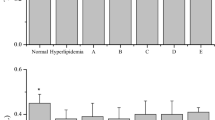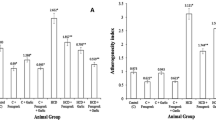Abstract
Three compounds capsaicin, curcumin and ferulic acid showing hypolipidemic activity have been tested in adult Wistar rats fed high fat diets. Capsaicin (0.20 mg%) fed to female rats along with a 30% saturated fat diet lowered the rate of weight gain, liver and serum triglycerides. In male rats it lowered only the liver and serum total and very low density and low density lipoprotein triglycerides whether fed continuously for 13 or 8 weeks after interchanging the control and test diets from the 5th week onwards. Capsaicin fed to female rats in 30% mixed fat diet increased the rate of weight gain, lowered liver and serum triglycerides, lowered adipose tissue lipoprotein lipase, elevated the hormone sensitive lipase and serum free fatty acids. Capsaicin in 30% saturated fat diet lowered both the enzyme activities to a much lesser extent. Curcumin and ferulic acid (both at 25 mg%) in 30% saturated fat diet tended to lower the rate of weight gain, liver total lipids and serum triglycerides. It is of significance that a common dietary compound ‘capsaicin’ in the range of human intake triggers lipid lowering action in rats fed high fat diets.
Similar content being viewed by others
Abbreviations
- BSA:
-
Bovine serum albumin
- TG:
-
triglyceride
- E I-III:
-
experiments I-III
- LPL:
-
lipoprotein lipase
- HSL:
-
hormone sensitive lipase
- FFA:
-
free fatty acids
- LDL:
-
low density lipoproteins
- HDL:
-
high density lipoproteins
- VLDL:
-
very low density lipoproteins
- PDE:
-
phosphodiesterase
References
Anonymous (1986) Nutr. Rev.,44, 20.
Bernhart, F. W. and Tomarelli, R. M. (1966)J. Nutr.,89, 495.
Govindarajan, V. S. (1985)Crit. Rev. Food Sci. Nutr.,22, 109.
Govindarajan, V. S. (1986a)Crit. Rev. Food Sci. Nutr.,23, 207.
Govindarajan, V. S. (1986b)Crit. Rev. Food Sci. Nutr.,24, 245.
Govindarajan, V. S., Rajalakshmi, D. and Nagin Chand (1987)Crit. Rev. Food Sci. Nutr., (in press)
Kalopissis, A. D., Griglio, S., Malewiak, M. I. and Rozen, R. (1980)Biochim. Biophys. Acta,620, 111.
Kawada, T., Hagihara, K. and Iwai, K. (1986a)J. Nutr.,116, 1272.
Kawada, T., Watanabe, T., Takaishi, Tanaka, T. and Iwai, K. (1986b)Proc. Soc. Exp, Biol. Med.,183, 250.
Khoo, J. C. and Steinberg, D. (1975)Methods Enzymol,35, 181.
Monsereenusorn, Y. (1983)Res. Commun. Chem. Pathol. Pharmacol. 41, 95.
National Academy of Sciences (1963)Natl. Res. Counc.Washington, Pub. No. 1100.
Neelands, P. J. and Clandinin, M. T. (1983)Biochem. J.,212, 573.
Newsholme, E. A. and Crabtree, B. (1976)Biochem. Soc. Symp.,41, 61.
Nopanitaya, W. (1973)Growth,37, 269.
Sambaiah, K., Satyanarayana, M. N. and Rao, M. V. L. (1978)Nutr. Rep. Int.,18, 521.
Sambaiah, K. and Satyanarayana, M. N. (1980)Indian J. Exp. Biol.,18, 898.
Sambaiah, K. and Satyanarayana, M. N. (1982)J. Biosci.,4, 425.
Sambaiah, K., Srinivasan, M. R., Satyanarayana, M. N. and Chandrasekhara, N. (1984)J. Food Sci. Technol.,21, 155.
Sambaiah, K. and Satyanarayana, M. N. (1987)Curr. Sci., (in press).
Schotz, M. C., Garfinkel, A. S., Huebotter, R. I and Stewart, J. E (1970)J. Lipid Res.,11, 68.
Singh, A., Balint, J. A., Edmonds, R. H. and Rodgers, J. B., (1972)Biochim. Biophys. Acta,260, 708.
Srinivasan, M. R., Sambaiah, K., Satyanarayana, M. N. and Rao, M. V. L. (1980)Nutr. Rep. Int.,21, 455
Srinivasan, M. R. and Satyanarayana, M. N. (1986)Nutr. Rep. Int.,34, 365.
Wang, J-P, Hsu, M-F, Hsu, T-P and Teng, C-M (1985)Thrombos Res.,37, 669.
Watanabe, T., Kawada, T., Yamamoto, M. and Iwai, K. (1987)Biochem. Biophys. Res. Commun.,142, 259.
Waterman, H. I. (1951)Hydrogenation of Fatty Oils (New York: Elsevier Publication).
Author information
Authors and Affiliations
Rights and permissions
About this article
Cite this article
Srinivasan, M.R., Satyanarayana, M.N. Influence of capsaicin, curcumin and ferulic acid in rats fed high fat diets. J. Biosci. 12, 143–152 (1987). https://doi.org/10.1007/BF02702966
Received:
Revised:
Published:
Issue Date:
DOI: https://doi.org/10.1007/BF02702966




